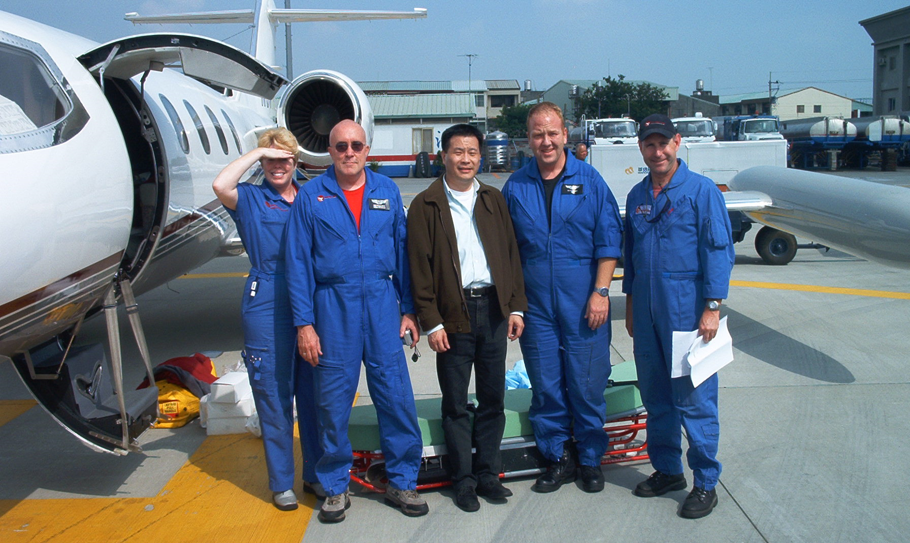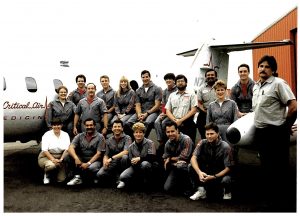Industry Voices Pay Tribute to the CFRN
Quick links: Industry Leader Tributes | Tributes from the First CFRNs
Hear what transport nursing pioneers and industry leaders had to say about the CFRNs 30th anniversary and the extraordinary nurses who hold the CFRN. Plus … hear from 6 nurses who sat for the very first CFRN exam on July 24, 1993.
Industry Leader Tributes to the CFRN

“Over the course of three decades, this esteemed certification program—the Certified Flight Registered Nurse (CFRN)—has propelled the field of flight nursing to unparalleled heights, forging a path of excellence and elevating the standard of care provided to patients in critical and aeromedical transport settings.
The CFRN credential stands as a testament to the unwavering dedication, expertise, and commitment of nurses who have gone above and beyond to enhance their skills and knowledge in this specialized domain. By maintaining this prestigious certification, nurses ensure their continued proficiency, guaranteeing the delivery of exceptional care and unwavering support to patients in their most vulnerable moments.”
– Allen C. Wolfe Jr., MSN, CNS, APRN, CFRN, CCRN-K, CTRN, TCRN, CMTE, FAASTN, Senior Director of Clinical Education, Life Link III and BCEN Board of Directors Chairperson-elect

“It is with the utmost respect and admiration that I congratulate the nurses, past, present and future, who have made a conscious and committed effort to ensure they are continually providing exceptional patient care by obtaining their Certified Flight Registered Nurse (CFRN) certification.
Over the past three decades, the care flight nurses provide has been advanced by obtaining the CFRN certification. The up-to-date education and training required of those with the CFRN certification helps to ensure excellent patient care. Nurses who earn and maintain the CFRN matter, as they are leaders in their field and encourage others to be exceptional by becoming certified.”
– Nikole Good, CAE, Chief Executive Officer, Air & Surface Transport Nurses Association
 “Congratulations on 30 years! I have always been proud of the creation of the CFRN and the very dedicated group of people who initially worked on it.
“Congratulations on 30 years! I have always been proud of the creation of the CFRN and the very dedicated group of people who initially worked on it.
Certification is a way of recognizing both the basic and specific education needed to safely practice in the transport environment. Having a specific certification focused on patient transport shows the dedication and the commitment to safe care for patients, including those I served as a transport nurse for over 25 years.”
– Reneé Semonin Holleran, FNP-BC, RN-BC, PhD, CEN/CFRN/CTRN (retired), CCRN (alumnus), FAEN, FAASTN. Renee is a former editor of multiple journals, a prolific author, educator, and researcher, and a transport nursing pioneer. She has been a CAMTS board of directors member since 1997.

“Congratulations on the CFRN 30th Anniversary! In verifying competence for critical care transport, a large part of our standards addresses safety, aircraft familiarization, and emergency egress procedures. Knowing that flight nurses have this advanced certification verifies that this knowledge is understood and shortens our review and auditing process.
Thank you BCEN for successfully continuing this well-accepted and needed certification.”
– Eileen Frazer, RN, CMTE, Executive Director, Commission on the Accreditation of Medical Transport Systems (CAMTS)
 “Flight programs for emergency medical services response and for critical care interfacility transport provide a vital safety net, allowing patients to more quickly arrive to definitive hospital care while receiving advanced treatment enroute. Flight nurses who earn and maintain the CFRN credential demonstrate a commitment to the profession and their patients.
“Flight programs for emergency medical services response and for critical care interfacility transport provide a vital safety net, allowing patients to more quickly arrive to definitive hospital care while receiving advanced treatment enroute. Flight nurses who earn and maintain the CFRN credential demonstrate a commitment to the profession and their patients.
We know professional certification matters—it saves lives. Congratulations to all the CFRNs out there and thank you to BCEN for supporting the specialty of flight nursing!”
– Jacqueline C. Stocking, PhD, MBA, MSN, NEA-BC, CMTE, CEN, CFRN, FP-C, CCP-C, RN, NRP, FAASTN, co-editor of Air Medical Journal and Assistant Professor and Vice Chair for Patient Quality and Safety at UC Davis. A former ASTNA president and former BCEN board member, Jackie is an internationally recognized expert in critical care transport, quality improvement, and patient safety.

“My first recollection of knowing about the CFRN was very early in my career, around 1996. I worked alongside a nurse named Jim whom I thought very highly of. Jim worked in the ED with me part time. His full-time job was flying. Jim was a CFRN, and he had explained to me what that was. I was just studying for my CEN at that time.
I can recall a night when Jim and the flight team had arrived on a very bad accident scene with a very critical patient. Jim and his team had stabilized the patient and flown him to our ED. Seeing Jim and his partner bring in this patient and do the handoff and talk about what they had already done for the patient was jaw-dropping. I was in complete awe. Jim knew what he was doing, and he wore that CFRN proudly. Few people back then were certified, and I was sure Jim could do anything and knew everything. It was extremely impressive.
Thank you CFRNs! Here’s to another 30 years of flight nursing excellence!”
– BCEN CEO Janie Schumaker, MBA, BSN, RN, CEN, CENP, CPHQ, FABC
Tributes from the Very First CFRNs
Charlann C. Staab, MSN, ACAGNP-BC, CFRN, CEN, FAEN
Chandler, AZ
July 1993 CFRN Exam Memories
“I was very excited to take the first exam, which I sat for in Phoenix. Prior to the CFRN, we were required to take and pass the CCRN.
We provided critical care as our patients typically were very ill and being transported from ED settings to ICU locations in tertiary facilities. But there was also a significant amount of critically injured patients from scenes. The CFRN addressed those knowledge proficiency requirements, so my program quickly adopted the CFRN as the standard for new hires within 1 year of completing their 3-month flight academy.”
CFRN 30th Anniversary Thoughts
“The CFRN was the first independent validation that was available for nurses working in the air medical industry. It was a needed and respected measurement of flight nursing as a specialty profession. Today, the CFRN is considered the entry level validation, and CFRN certification is one of the benchmarks for air medical programs wishing to hold CAMTS accreditation.”
Flight Nursing Career Highlights
My first position as a flight nurse was with Samaritan Air Evac in Phoenix, AZ, in 1985. I transported for 20 years, and then was promoted to various management positions including a national manager position after Air Evac became a subsidiary of PHI Air Medical. I retired from my Air Evac/PHI position in 2021 with 36 years in the industry. I am currently semi-retired working as a contract nurse practitioner, and I still serve as a CAMTS site surveyor in the U.S. and Canada.
Raymond A. Scollin, RN, CTRN, NREMT

Critical Care Transport Nurse, University of VT HealthNet Transport
Saranac Lake, NY
July 1993 CFRN Exam Memories
“When I learned I had passed the CFRN exam … and would be one of the first to obtain this certification … I was naturally proud. From my perspective, this was the beginning of validating and standardizing an expanded role of nursing practice in a nontraditional environment. I would join a group of ‘new’ pioneers. This motivated me to reach out beyond my work in Vermont to help on a national level. I became more active in the National Flight Nurses Association (NFNA), and was a contributor to the second edition of Standards of Flight Nursing Practice.”

CFRN 30th Anniversary Thoughts
“The medical community has been well-served by the leadership of organizations like ASTNA (then NFNA), and BCEN, which validated the knowledge and skills of our flight nurses. These standards have greatly benefited patients who encounter us in the most dire situations and in unusual locations.
The skills verification process BCEN launched has been remarkable. I believe it has strengthened our practice and the industry as a whole. In three months, I will be retiring after 43 years of nursing, which has been a wonderful career. Earning my CFRN remains a proud moment for me.”
Flight Nursing Career Highlights
My first flight nurse experiences began around 1983 in the rural New York State northern Adirondacks region, an served by a military program that provided assets to respond to assist civilian hospitals and EMS. In my region, we were supported by the Plattsburgh Air Force Base with UH-1 (Huey) aircraft and most often transporting to the university-based hospital in Burlington, VT. In 1989, we developed a civilian model program utilizing a New York State Police helicopter with North Country Life Flight, a private not for profit. I became their chief flight nurse in 1993—the same year I obtained my CFRN certification. I remained a flight nurse for ten years, and stayed in critical care transport afterwards. For over 20 years, I have been with the University of Vermont Medical Center’s critical care transport program. Initially a pediatric/adult ground program, the program now includes rotor-wing.
Laura M. Criddle, PhD, APRN-BC, CEN, CFRN, CTRN, CPEN, FAEN
Chief Clinical Officer, TCAR Education Programs
Scappoose, OR
July 1993 CFRN Exam Memories
“I was so excited to earn the CFRN certification. Having already earned several other specialty certifications including the CEN, I didn’t have any major fears or concerns about passing. In fact, I found certification was a really good strategy for me when I was making a career leap. I’m certain that the CFRN got me the first flight nurse job I applied for.”
CFRN 30th Anniversary Thoughts
 “I can clearly state that certification has been a very strong foundation of my career. It has gotten me where I wanted to go. Getting certified is something I did proactively, and it has made all the difference.
“I can clearly state that certification has been a very strong foundation of my career. It has gotten me where I wanted to go. Getting certified is something I did proactively, and it has made all the difference.
Even though flight nursing is one of many roles I’ve held, I have maintained the CFRN flight nursing certification throughout my career because I always want to make sure I have current knowledge. Without a doubt, being certified adds credibility, and it opens up a lot of doors.”
Flight Nursing Career Highlights
The Austin, Texas, hospital where I was a trauma CNS in the mid-90s had its own hospital-based transport program, called STARFlight Air Ambulance. When a position opened up, there must have been at least 15 candidates. I was the only one who was already certified, and I got the job. It was a huge shift going from my ED, critical care and trauma in-hospital roles to a front line, hands-on role doing about 80% scene calls, but earning the CFRN had prepared me well. At the time, I was the only CFRN. But by the time I left several years later, more than half of our nurses held the CFRN. I later took a position with a medical jet company doing international flights. I’m also proud to have served as a CFRN item writer and ECRC member.
Joe Bob Pearce, MSN, RN, CEN

ED RN, Nemours Children’s Hospital
Orlando, FL
July 1993 CFRN Exam Memories
“In 1993, I saw the news that there was going to be a flight nurse certification exam offered in Orlando. I’m not a great test taker, and I was hesitant to take that first exam. I agreed to take it after making a pact with three other flight nurses that they would take it then too. I walked out of the exam thinking I’d have to retake it. When the results came back, all I could do was grin like a (very happy) idiot!”
CFRN 30th Anniversary Thoughts
“Being in the first group of CFRNs never really sunk in until I saw that it was the CFRN’s 30th anniversary.

As part of the 30th anniversary celebration, I would like to tell flight nurses that having the CFRN certification validates the sense of accomplishment we have as flight nurses who possess advanced knowledge and skills.”
Flight Nursing Career Highlights
I began my flight nursing career with a startup program at the University of Florida Shands Hospital in Gainesville called ShandsCair. I had been a PICU RN at Shands Hospital and jumped at the chance to be on the brand new critical care transport team. I moved to Orlando in 1985 and was part of Orlando Medical Center’s Air Care Team until 2008. I’ve been an RN for 47 years, with 21 of those years as a flight nurse.
Thomas Culwell, RN, BSN, CEN, CCRN-K, CFRN
University Health
San Antonio, TX
July 1993 CFRN Exam Memories
“My flight company asked me about a month before the exam if I could travel from Texas to Alaska 2 weeks earlier than planned to help open new bases in Juno and Sitka. Computer testing did not exist back then. I said, if I can find a test available in that area, I’ll do it.
I ended up finding a test center in Anchorage, and leadership fully supported me in taking the exam. They even closed our base in Sitka for exam day. That morning, the bus dropped me and my suitcase over a mile from the testing center. It was a long, nerve-wracking walk, but I was determined to take the exam. Fortunately, my studying and perseverance paid off, and I passed it!
After passing the exam, many coworkers asked me to help them study for the CFRN. I created a 4-part review and study guide with practice questions, study recommendations, posttest, and the CFRN handbook. I was trying to help people get there—I was committed to this!”
CFRN 30th Anniversary Thoughts
 “I want to thank and congratulate the BCEN for setting a recognized and well-respected standard of practice and credentialing for flight nurses. I am proud of all my certifications, but I’m proud at a higher level of my CFRN because of the nostalgia of being one of the originals, and because my flight nursing days are so precious.”
“I want to thank and congratulate the BCEN for setting a recognized and well-respected standard of practice and credentialing for flight nurses. I am proud of all my certifications, but I’m proud at a higher level of my CFRN because of the nostalgia of being one of the originals, and because my flight nursing days are so precious.”
Flight Nursing Career Highlights
I flew for Critical Air Medicine for more than four years, from 1992-1996. I worked my way up from flight nurse to base manager to Regional Chief Flight Nurse, then went on to work in various roles in critical care, emergency care, and education. I helped train and evaluate paramedics. And now I have been back in management for the past 19 years. I kept my CFRN through it all. Additionally, it was an honor to co-author portions of Flight Nursing: Principles and Practice (2nd edition). Prior to this, almost everything published about flight nursing was from a rotor wing perspective. In this book, we broke new ground with sections on Fixed-Wing Flight Nursing, Air Medical Service International Transports, and Escort / Medical Assist Transports on Commercial Airliners.

Bonita Haggith, RN, CFRN, CCRN, CEN
Airlift Northwest
Seattle, WA
July 1993 CFRN Exam Memories
“My memories of taking the CFRN exam on July 24, 1993, are vivid because it was the due date for my daughter. So yes, I waddled into the testing site, took the exam, and amazingly passed, even with my pregnant fogged brain. I made my husband take me just in case I went into labor.
I had been a flight nurse for three years at that time and wanted to validate my knowledge of nursing care for critically ill and injured patients. I went into labor and delivered a healthy baby girl three days later on July 27, 1993.”
CFRN 30th Anniversary Thoughts
“I chose to get certified to see how my knowledge, skills, and clinical practice compared with current national best practices. Health care is constantly changing, so staying on top of new information is more important than ever. When I passed it gave me a sense of personal satisfaction and accomplishment that I was in-the-know when caring for my patients.

Happy Anniversary to 30 years of the CFRN!!”
Flight Nursing Career Highlights
I started my career as a flight nurse after working as a critical care/ED nurse for 12 years because I decided I needed a challenge. I started with MedFlight, a hospital-based program with St. Joseph Hospital in Bellingham, WA, in 1990. At that time, we worked as ED nurses giving up our patients when we were called out for a flight. In 2000, the hospital decided it could no longer support a flight program and asked the nearest flight program at that time to take it over. It was a stressful time, as we all lost our jobs as flight nurses and had to reapply to the new program, Airlift Northwest, a flight program out of the University of WA, Seattle, WA. I was fortunate enough to be hired.
I have been a flight nurse for 33 years and am still working full-time flying patients around the Pacific Northwest with Airlift Northwest. Taking care of patients in their greatest need on what might be the worst day of their lives has been an honor and a privilege that I feel blessed to have been a part of.
Debbie K. Martin, MSN, RN, CCRN (ret.), CMTE
Rochester, MN
July 1993 CFRN Exam Memories
“I recall feeling a moderate degree of pre-test angst, as there were very few review books available at that time. That said, I was very thankful to Genell Lee and Reneé Semonin Holleran for publishing the 1st edition of Flight Nursing Principles and Practice, which was my primary study resource.

During the exam, I recalled previous ICU and transport patients I had cared for and applied knowledge and experience gained in those scenarios to the exam questions. I felt very fortunate that my transport practice had included patients requiring intra-aortic balloon pumps, mechanical ventilation, NICU or PICU teams, and other specialized critical care needs.
I was ecstatic—and relieved—upon receiving the letter informing me of a passing score! I was always proud of attaining my self-motivated goal as a CFRN, but I had never really thought about it being the initial exam ever offered. I looked at the CFRN as a way to objectively quantify my knowledge of the specialty, a measure of quality for the patients and families entrusted to my care.”
CFRN 30th Anniversary Thoughts
“I am deeply indebted to my first transport preceptor, Jill F., for exhibiting (and expecting nothing less from her charges) excellence in patient care, and from whom I learned the ‘art’ of transport nursing. I was able to utilize much of her sage advice throughout the years that followed.
It is my sincere hope for safety and success for all those participating in the specialty of flight nursing. I truly believe it to be a special calling, and am humbled by the patients, families, and opportunities of which I have been able to contribute to.”
Flight Nursing Career Highlights
My transport career actually started in a Greyhound bus converted into a mobile ICU based at the University of Wisconsin-Madison Hospital and Clinics, which preceded their acquisition of a helicopter. We had everything except radiology on board ‘the Bus,’ and the largest ‘red bubble light’ that I have ever seen. I subsequently enjoyed 27 years in flight nursing out of a total 35 years in transport.
I had the privilege to serve as one of the initial helicopter team leaders for Life Link III in St. Paul, Minnesota, and we had a Bell 222UT as our primary ship! Life Link provides ground, fixed, and rotor-wing critical care transport, and we were cross-trained for all modalities. Most recently, I worked in the Midwest Admission and Transfer Center at Mayo Clinic in Rochester, MN, working closely with Mayo Medical Transport Dispatch colleagues. I retired in April 2023 after a 45-year critical care nursing career. I remain humbly privileged to continue serving on the Editorial Board of Air Medical Journal.
For more on the history of flight nursing and the CFRN, read our Walk Back Through CFRN History and Excellence in the Air: The CFRN.
View more photos and comments from the CFRN community in our 30th Anniversary CFRN gallery.
The Certified Flight Registered Nurse (CFRN®) is a registered trademark of the Board of Certification for Emergency Nursing (BCEN).



